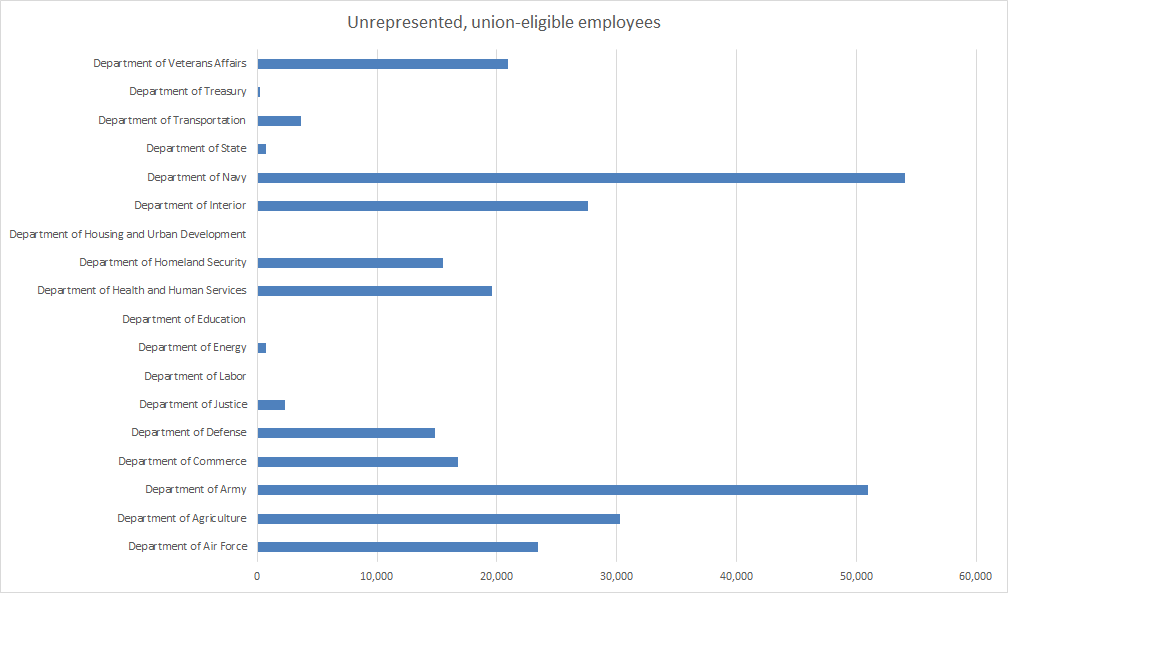

The Office of Personnel Management highlighted information available in FedScope to aid federal unions in targeting union-eligible employees.
Best listening experience is on Chrome, Firefox or Safari. Subscribe to Federal Drive’s daily audio interviews on Apple Podcasts or PodcastOne.
The Office of Personnel Management has offered some extra help to federal unions looking to add eligible employees to their membership rosters.
Federal unions have tools available in FedScope, OPM’s online federal employee database, to identify which agencies have the largest amounts of unrepresented workers, said Tim Curry, OPM’s deputy associate director for accountability and workforce relations, in an email obtained by Federal News Network.
“OPM is assessing ways to improve, consistent with applicable law, data transparency on bargaining unit eligibility in all agencies,” Curry wrote.
The email aimed to highlight to unions where information on federal employees, including their bargaining unit status, was already publicly available. Federal News Network has also extracted and analyzed the data. You can find a table summarizing the agencies with the largest percentages of non-unionized employees here.
The reminder from OPM stemmed from just one of nearly 70 recommendations that the White House task force on worker organizing and empowerment released in February, focused on “removing unnecessary barriers and obstacles which impede the ability of federal employees to exercise their right to organize and other labor rights under the law.”
Specifically, one task force recommendation asked OPM to make it easier for federal unions to reach the more than 300,000 feds who are eligible to join a union but who are currently unrepresented.
“OPM should engage with the agencies with the largest shares of these 300,000 employees to assess opportunities for unions to expand coverage consistent with applicable law, improve data transparency on bargaining unit eligibility in all agencies and develop guidance and fact sheets on how eligible employees can form or join unions,” the task force’s February report stated.
The National Federation of Federal Employees voiced its support for the FedScope search function. The union said it will use the data from OPM to help locate and target certain offices with higher rates of unrepresented employees.
“This upgraded resource will be an excellent tool for our union to locate non-union employees across the federal government who are rightfully entitled to representation and a voice in their workplace,” NFFE National President Randy Erwin said in an Aug. 17 press release. “NFFE specifically requested assistance in identifying the hundreds of thousands of unrepresented government workers, and today OPM delivered on its commitment to promote employee organizing and collective bargaining by rolling out the enhanced database. We are excited to help these federal employees who have not yet joined a union organize in their workplaces and obtain critical rights and benefits through unionizing.”
The National Treasury Employees Union has also called for other ways to better access to currently unrepresented, but union-eligible, federal workers.
“If we are provided access to email addresses, then we can do a lot of communicating with those folks about the fact that they can belong to a union and what belonging to the union does for them,” NTEU National President Tony Reardon told Federal News Network in July. “Then they can make whatever choice that they make, whether they’re going to belong to the union or not.”
After drilling down into FedScope’s data, some agencies showed fairly high numbers of unrepresented employees. For example, data compiled by Federal News Network from FedScope showed that the Agriculture Department has nearly 30,300 union-eligible employees not in a bargaining unit. The Department of Veterans Affairs has 20,900 and the Interior Department has around 27,600. Some of the agencies with the highest number of eligible, yet unrepresented, employees are in the Defense Department.
On the other hand, the departments of Education, Energy, Labor, State and Treasury, as well as the Department of Housing and Urban Development, were among the agencies with the lowest numbers of unrepresented workers. The most recent data available in FedScope is from March 2022.

Breaking down the data further, though, the numbers are a little different. The Veterans Health Administration at VA, for example, has the highest number of unrepresented employees of any agency subcomponent — nearly 17,900 workers union-eligible, but currently not part of a bargaining unit. But with hundreds of thousands of employees at VHA overall, that number represents just 4.7% of the total union-eligible workforce.
Copyright © 2024 Federal News Network. All rights reserved. This website is not intended for users located within the European Economic Area.
Drew Friedman is a workforce, pay and benefits reporter for Federal News Network.
Follow @dfriedmanWFED

